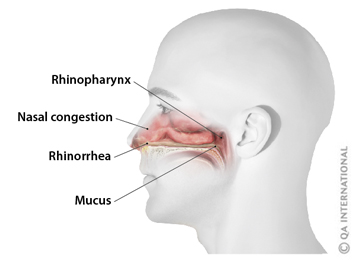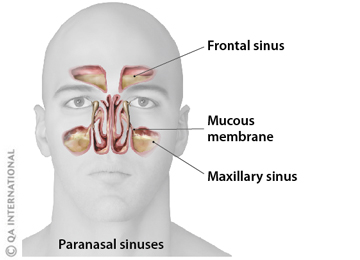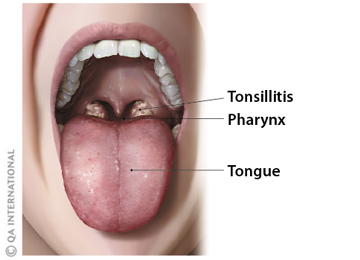
Respiratory infections: beware of complications!
Inhaled air often contains bacteria or viral pathogens capable of causing the infection of the respiratory tract. Generally harmless, these infections are resolved spontaneously in a few days, but drugs may relieve their symptoms: local pain, mucus discharge, fever, fatigue, respiratory difficulty. However, sore throat, sinusitis, and laryngitis must be treated and monitored in young children because they may cause serious complications.
The common cold
The common cold, or acute rhinitis, is an inflammation of the mucous membranes of the nasal fossae caused by a viral infection. This harmless but very contagious ailment is manifested by:
|
 |
The symptoms are relieved by decongestants and antifever drugs. Warning! If you use a decongestant, be sure to follow the dosage indicated and do not combine it with other drugs without a doctor's approval. The discharge of mucus in the throat may spread the infection to the pharynx and larynx. Infection of the rhinopharynx, or rhinopharyngitis, may develop into otitis (ear infection) in children and sinusitis in adults.
SinusitisSinusitis is an inflammation of the paranasal sinuses, which is generally caused by the spread of an already existing infection such as a cold or dental infection. It is manifested by:
|
 |
Sinusitis that persists more than three months may be due to a secondary infection, allergy, deviation of the nasal septum, or an obstruction (due to a polyp, for example) in one of the sinuses. Untreated, sinusitis may develop into meningitis.
Sore Throat
A sore throat is an infection of the throat. It is often associated with tonsillitis and pharyngitis. Sore throat is normally caused by the common cold or flu virus, but may also be caused by a bacterium, most often a streptococcus. Frequent in children and adolescents, it manifests itself as a sharp pain in the throat, accentuated by swallowing, and the swelling of the lymph nodes in the neck. While a sore throat of viral origin spontaneously resolves, a streptococcal sore throat must be treated by antibiotics due to its possible complications. The viral or bacterial origin of a sore throat is determined by a bacteriological test carried out on a sample.
|
Tonsillitis is an inflammation of the tonsils. Upon observation, the tonsils may appear red or covered with white spots. A tonsillectomy, or removal of the tonsils, is performed in case of repeated infections or when the tonsils are too large and obstruct the pharynx. The operation requires one day of hospitalization and is performed under general anesthesia. |
 |
Pharyngitis is an inflammation of the pharynx. Acute pharyngitis, of infectious origin, is often associated with tonsillitis. Chronic pharyngitis may be due to chronic rhinitis or sinusitis, gastric reflux, or the irritation of the pharynx by tobacco, alcohol, or chemical products.
Laryngitis
Laryngitis is an inflammation of the larynx. Acute laryngitis, most often of viral origin, is frequent in children. It must be monitored because it could cause an obstruction of the larynx and require an emergency intubation. Chronic laryngitis may be caused by the spread of an infection (sore throat, sinusitis, dental infection), by overtaxing the voice, or by smoking. Laryngitis causes:
- a hoarse,
- dry cough,
- pain in the throat,
- and an inflammation of the vocal cords, which results in hoarseness of the voice and which can lead to losing the voice altogether.
Tracheitis
Tracheitis is an inflammation of the trachea, of viral or bacterial origin, often associated with another respiratory tract infection (cold, bronchitis, etc.). It is manifested by:
- fits of dry coughing, sometimes becoming loose,
- and a feeling of discomfort in the chest.
Its treatment is based on antitussives.
Also see:
In the Visual Dictionary
In the encyclopedic capsules :




